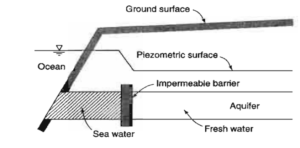The methods of controlling intrusion vary widely depending on the source of the saline water, the extent of the intrusion, local geography, water use, and economic factors. The most useable methods for the coastal aquifer in as bellow. The methods of controlling the saline water intrusion are depends on the budget and people involved in the problems. The govt can take the initiatives to make the artificial barrier and other methods as we have discussed in the section below. Here is the most useable methods are explained.
Methods of controlling saline water intrusion:
| Source or Cause of Intrusion | Control Methods |
| Sea water in coastal aquifer | Modification of pumping pattern
Artificial recharge Extraction barrier Injection barrier Subsurface barrier |
| Up coning | Modification of pumping pattern
Saline scavenger wells |
| Oil field brine | Elimination of surface disposal
Injection wells Plugging of abandoned wells |
| Surface infiltration | Elimination of sources |
| Saline water zones in freshwater aquifer | Relocation and redesign of wells |
-
Controlling of saline water intrusion by modification of pumping pattern:
Changing the location of pumping wells, typically by dispersing them in inland areas, can aid in reestablishing a stronger seaward hydraulic gradient. Also, reduction in pumping of existing wells can produce the same beneficial effect.
-
Controlling of saline water intrusion by Artificial recharge:
Groundwater levels can be raised and maintained by artificial recharge, using surface spreading for unconfined aquifers and recharge wells for confined aquifers. This necessitates development of a supplemental water source.
-
Controlling of saline water intrusion by Extraction barrier:
An extraction barrier is created by maintaining a continuous pumping trough with a line of wells adjacent to the sea. Seawater flows inland from the ocean to the trough, while fresh water within the basin flows seaward toward the trough. The water pumped is brackish and normally is discharged into the sea.

Fig: Control of seawater intrusion by an extraction barrier
-
Controlling of saline water intrusion by Injection barrier:
This method maintains a pressure ridge along the coast by a line of recharge wells. Injected fresh water flows both seaward and landward. High quality imported water is required for recharge into wells. A combination of injection and extraction barriers is feasible, this reduces both recharge and extraction rates but requires a large number of wells.

Fig: Control of seawater intrusion by an injection barrier
-
Controlling of saline water intrusion by Subsurface barrier:
Construction of an impermeable subsurface barrier parallel to the coast and through the vertical extent of the aquifer can effectively prevent the inflow of seawater into the basin. Materials to construct a barrier might include sheet piling, puddled clay, emulsified asphalt, cement grout, bentonite, silica gel, calcium acrylate, or plastics. Chief problems are construction cost and resistance to earthquakes and chemical erosion.

Fig: Control of seawater intrusion by an impermeable subsurface barrier